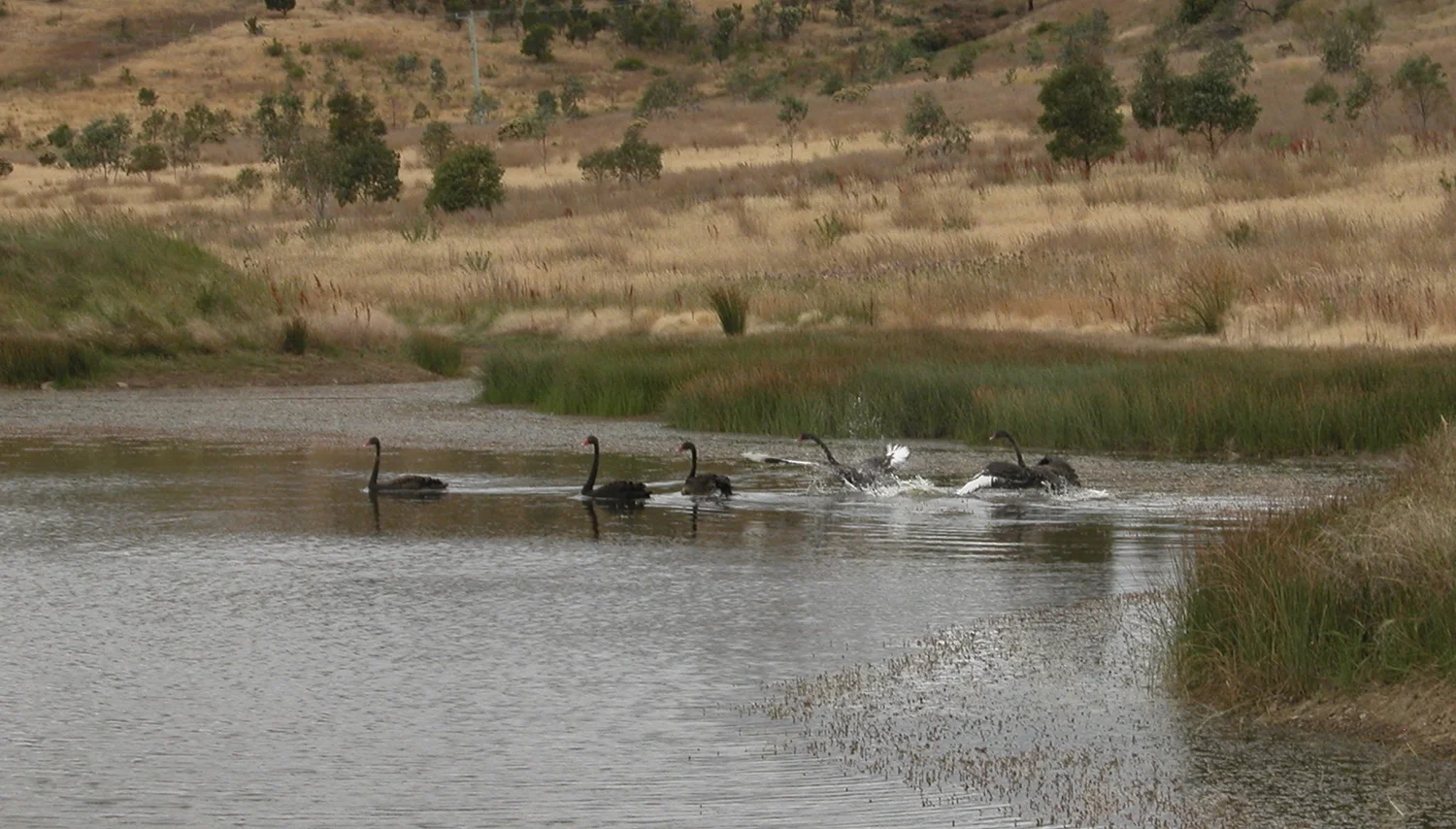The question, all spring, has been: “Is that a mating pair, or are they brother and sister?” Last year the parents of one (or both—or possibly neither, but I’m not willing to accept that option) nested in wintry July and raised a clutch of five cygnets, who took wing in December, but have returned sporadically since. So I’ve been watching these two for any sort of courtly behaviour.
They often hang out at Willow Tree Pond for morning coffee, though Swan Lake is their real home. And a couple of weeks ago, I was hopeful—even thought I might have seen some nest building, but they haven’t kept at it. So, instead of writing about the youngsters, I’ll let you read what I wrote about their parents. It was meant to be the first Yarn from the Farm, back in January when I foolishly thought the website might be ready to go before long…
The Swans Come Home
Today the swan family came home again. Five sleek black swans appeared this morning on the small waterhole that provides stock water for the farm. Later in the day, they moved to the wetlands where the cygnets were born and raised last spring.
The story begins about this time last year. Well, actually, the story really begins in the early days of this century, when I decided to plant an ecosystem. This was not long after I myself came back to the farm, leaving a well-paid but intensive job to concentrate on raising sheep and managing the landscape in an environmentally sensitive way. My training as a physicist left me ill-prepared for the challenges of complex ecosystem dynamics, and I genuinely believed I could plant an ecosystem.

The prodigals on Swan Lake
When my friend and ecologist Graham Harris stopped laughing long enough to talk, he explained, mostly in words of one syllable that a physicist could understand, that ecosystems aren’t planted, they evolve. You can plant elements of an ecosystem, and if you’re lucky, sometime long after you’re dust again, an ecosystem may indeed develop.
So, what I have is an ecosystem-in-waiting (I hope), and the centerpiece is an existing farm waterhole. During the long dry spell of 2006-2009, when the waterhole, too, was dry, I used fill from landscaping around the house to make islands. With financial support from the Natural Heritage Trust, I then planted elements of my ecosystem in the surrounding 12 hectares, using seeds sourced mainly from around the farm.
Another good friend, Biz Nicolson, of Taz Wild, germinated the seeds, grew the seedlings and helped me plant about 7000 plants and another 7 km of direct seeding. We did this in the second year of the long dry, and ran out of farm water to do more than water them in. A surprising number survived, as you can see in the comparison photos. I then excluded sheep for about 4 years, and let the waterhole evolve toward a wetland. (You can see more photos in the Enhancing Biodiversity photo gallery on the website.)
In autumn last year, two mature swans showed up on the smaller waterhole that feeds the stock watering system—the one I call Willow Tree Pond. After hanging out for a while there, they moved to the wetlands (aka Swan Lake), about a kilometer away, and in July began building their nest. I was delighted. I felt honoured that they liked the habitat well enough, and felt safe enough, to raise their family in my ecosystem-in-waiting.

Mama and Papa arrive (March 2012)

On the nest in an August blizzard
I watched mama and papa take turns keeping the eggs warm, even through blizzards. I watched the five fuzzy grey babies forage on the dam wall for weeks before they began to forage more regularly underwater. I watched as flying lessons began, months later. I began to believe that they were MY swan family, and that they would be there forever.

Cygnets shortly after hatching.

Swan Lake before planting in 2008
Then one day in December, I saw all seven in flight together for the first time. They flew to the small waterhole, and then left. Just left. No goodbye, no note about when to expect them back, if ever. And I had to accept (never my strong point) that they had their own lives to live, and that their sojourn in my wetlands was a gift. It was another gift to see five of them back this morning. I don’t know who is missing, but I’m going to imagine that two of the youngsters have found mates and are looking for their own place to start raising the next generation of swan family.

